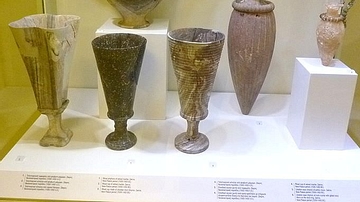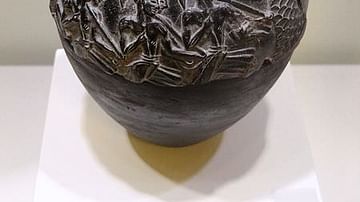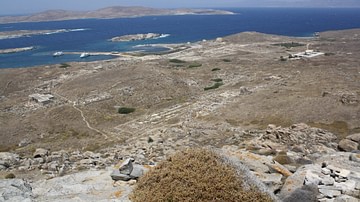Search Images
Browse Content (p. 1701)

Image
Severus Alexander Bust, Vatican Museums
A marble bust of Roman emperor Severus Alexander, r. 222-235 CE. (The Vatican Museums, Rome).

Image
Bust of Antoninus Pius
A marble bust of Roman emperor Antoninus Pius, r. 138-161 CE. (The Vatican Museums, Rome).

Image
Commodus
A marble bust of Roman emperor Commodus, r. 180-192 CE. (The Vatican Museums, Rome).

Image
Minoan Rock-Crystal Bowl
A Minoan rock-crystal bowl in the form of a duck, 16th century BCE. The vessel was found at Mycenae but has been attributed to the earlier Minoan civilization based on Crete. The vessel was probably used to store cosmetic creams. (National...

Image
Minoan Stone Vases
A range of stone vessels from Minoan Crete, 15th century BCE. (Archaeological Museum of Herakllion, Crete).

Image
Harvester Vase
The Minoan stone vessel known as the 'Harvester Vase', from Hagia Triada on Crete, 1500-1450 BCE. The vase is carved from serpentine and was originally covered in gold leaf. The scenes in relief depict a sowing festival and the vase was probably...

Image
Minoan Rock-Crystal Vase
A Minoan vase carved from rock-crystal, from Zakros on Crete, c. 1450 BCE. The collar includes gilded ivory discs and the handle is made from rock-crystal beads strung on bronze wire. The vessel was probably used to pour liquids in religious...

Image
Map of the Frankish Kingdoms AD 511
The founder of the Merovingian Frankish kingdom was Clovis. He followed an aggressive policy of conquest to build up the kingdom over much of modern France, but his death in 511 saw his realm chopped up into several smaller kingdoms. It...

Image
Map of the Frankish Kingdoms AD 481-511
With the accession of Clovis, son of Childeric I of the Salian Franks, the Germanic occupiers of north-eastern Gaul had found a king who would change their fortunes out of all recognition. Rather than follow his father's policy of allying...

Image
Delos Panorama
A panorama of the archaeological site of Delos, one of the most important religious sanctuaries in the Greek world and a major trading centre in the 1st and 2nd century CE Roman world.